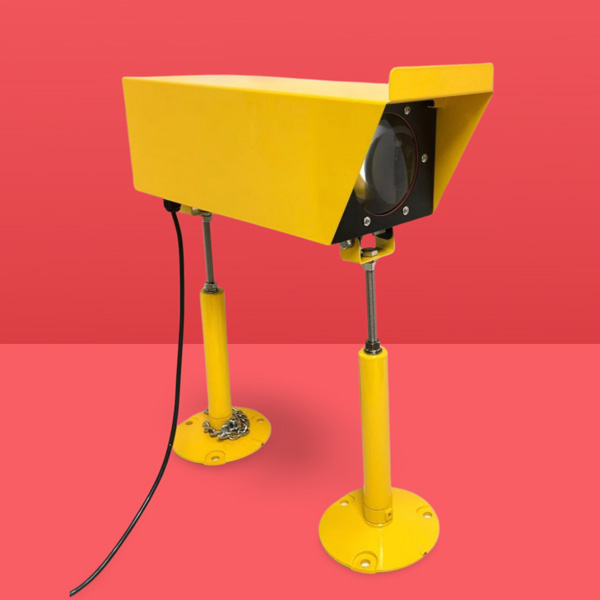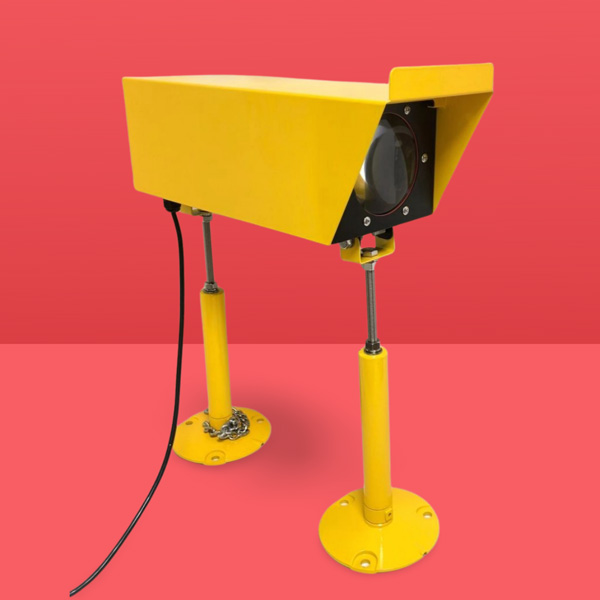
Detailed introduction
The Helicopter Approach Path Indicator (CHAPI) light and CHAPI system are essential tools for ensuring safe helicopter operations.
The CHAPI system is designed to provide clear visual guidance to helicopter pilots during approach and landing. It consists of a series of lights that are strategically placed to mark the ideal approach path. The CHAPI lights are highly visible, even in low visibility conditions, and are designed to be easily distinguishable from other lights on the ground.
The CHAPI light typically emits a bright, steady or flashing light that can be seen from a distance. The color and pattern of the light are carefully chosen to ensure maximum visibility and to distinguish it from other lights in the area. Some CHAPI systems may also include additional features such as variable intensity settings or color changes to provide more detailed information to pilots.
The CHAPI system is particularly useful in areas where there are limited visual cues or where the terrain is complex. It helps pilots to maintain a safe approach path and to avoid obstacles such as power lines, buildings, or mountains. By providing clear visual guidance, the CHAPI system reduces the risk of accidents and enhances the safety of helicopter operations.
In addition to its safety benefits, the CHAPI system can also improve operational efficiency. By providing a consistent and reliable approach path, it can help to reduce flight times and fuel consumption. This can be especially important for commercial operations or in emergency situations where time is of the essence.
Overall, the Helicopter Approach Path Indicator light and CHAPI system are essential tools for ensuring safe and efficient helicopter operations. They provide clear visual guidance to pilots and help to reduce the risk of accidents and improve operational efficiency.

Overview:
The CHAPI Light System, fully known as Heliport Approach Path Indicators and abbreviated as CHAPI. The "C" in CHAPI stands for 'Cramp', the name of the person who invented this system 40 years ago. As a result, even up to now, we still use CHAPI as a short name for HAPI lights. Our LED CHAPI utilizes LED technology to provide pilots with a safe and accurate glide slope during the final approach to the helipad. A set of two LED CHAPI Light Housing Assemblies (LHAs) are visible to the pilot, showing combinations of white, green, and red colors to indicate whether the path is too high, too low, or within the 6° ±0°15′ glide slope. Angle deviations that are excessively high display one or two white lights, while those that are too low show one or two red lights. The visual indication of HAPI lights is as follows: one helipad requires two pieces of HAPI lights.

Compliance:
1. ICAO Annex 14 Volume II Heliports 5.3.
2. FAA AC 150/5390-2B Heliport Design Guide
Features:
1. Utilize super bright brand LEDs that exhibit high intensity while having lower energy consumption.
2. The input voltage can be either DC (ranging from 12 to 48V DC) or AC (100 - 265V AC, with a frequency of 50 - 60Hz).
3. A clear polycarbonate lens is employed for converging light. Additionally, it provides corrosion resistance and UV protection.
4. The efficient photometric design offers excellent light distribution, guaranteeing compliance with the requirements of ICAO and FAA.
5. The housing material is stainless steel, which has strong corrosion resistance and offers protection against shock and vibrations.
6. The UV-protected powder-coated bright yellow base increases visibility.
7. The fragile coupling effectively reduces secondary damage to helicopters.
Specification:
|
Product Name |
Helicopter Approach Path Indicator CHAPI light CHAPI system AO-HP-CHAPI |
|
Mode NO.: |
AO-HP-CHAPI |
|
Color: |
White,Green and Red |
|
Light source:
|
LEDs |
|
Body materials: |
Stainless steel |
|
Leg Materials: |
Die casting aluminum with Fragile coupling |
|
Installation type: |
Surface mounting |
|
Flashing Characteristics:
|
steady burning with fixed light
|
|
Operation Mode: |
24 hours after power on |
|
Input: |
100-240VAC 50-60Hz, 12-48VDC(Details contact us) |
|
Power Consumption(W): |
Average Power consumption <20W |
|
Circuit Protection: |
Integrated |
|
Helipad Light Material: |
lens and Powder coated Stainless steel |
|
Weight(kg): |
10kg |
|
IP Grade: |
IP65 |
|
Work environment: |
-50℃~+60℃, Humidity 0%-100% |
|
Optional functions(Separate charges): |
1. VHF pilot to ground remote control 2. Clinometer 3. Solar powered system |
Dimension & Installation:

The recommended location for installing the CHAPI Light is shown in the picture above. The size of the helipad depends on your location and the maximum rotor diameter. The 3.28-foot dimension listed is crucial for locating the CHAPI closest to the helipad and assisting helicopter pilots. Once the elevation and exact physical location of the light boxes are determined, mount the light boxes on the pads.
Applications:
The CHAPI Light System, also referred to as the Helicopter Approach Path Indicator and glide path indicator with the model AO-HP-CHAPI, is an extremely valuable tool for helicopter operations.
Regarding application locations, it is typically found at heliports, hospitals equipped with helipads, offshore oil rigs, and other areas where helicopters need to land safely. These locations often have specific demands for accurate approach paths due to limited space, challenging terrain, or high-stakes operations.
The application scenarios of the CHAPI Light System are diverse. In emergency medical services, it assists in guiding helicopters to land rapidly at hospitals, enabling the timely transportation of patients. On offshore platforms, it ensures safe landings for crew changes and supply deliveries. At military bases, it helps with precision landings for various missions.
The CHAPI Light System employs advanced technology to offer clear visual cues to pilots. It comprises a set of lights that indicate the correct glide path for approach. The lights are highly visible even in adverse weather conditions. By emitting different colors such as green for on-path, red for too low, and white for too high, pilots can easily adjust their approach.
This system is designed to meet the stringent standards of aviation authorities like ICAO and FAA. It is durable and reliable, capable of withstanding the harsh environments frequently encountered in helicopter operations. With its precise guidance and visibility, the CHAPI Light System plays a crucial role in ensuring the safety and efficiency of helicopter landings in a wide variety of applications.

